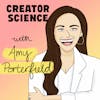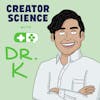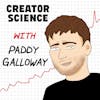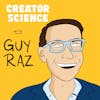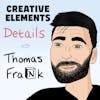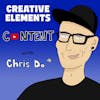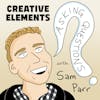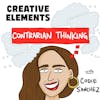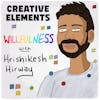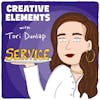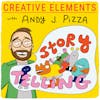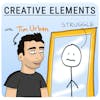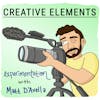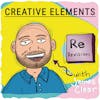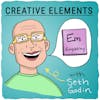
#110: Polina Marinova Pompliano – How "The Internet's Biographer" writes great profiles
Play EpisodePolina Pompliano is the author of The Profile, which studies the most successful and interesting people and companies in business, entertainment, tech, sports, and more.
WATCH
▶️ Watch this episode on YouTube
***
EPISODE DESCRIPTION
Polina Pompliano is the author of The Profile, which studies the most successful and interesting people and companies in business, entertainment, tech, sports, and more.
The Profile is a paid newsletter. Before Polina was writing The Profile, she wrote for Fortune, USA Today, and CNN. Polina also has nearly 130,000 followers on Twitter and in order to write exceptional profiles, says she read 1.8 million words online last year – the equivalent of 25 books.
Profiles are a rare breed of writing – and Polina is really good at it. She’s written profiles of Sara Blakely, Elon Musk, Dwayne The Rock Johnson, Dolly Parton, Kris Jenner, and many more.
In this episode, we talk about the difference between profiles and biographies, the economics behind a paid newsletter, the most effective strategies she’s found for growth, and why the secret to a great profile is found in the Details.
Full transcript and show notes
Follow Polina Pompliano on Twitter
TIMESTAMPS
00:12 - New projects
01:00 - Today’s guest
01:40 - Polina by the numbers
03:00 - What we learn today
03:40 - Why profiles are great
05:40 - Difference between profiles and biographies
06:58 - What makes a great profile?
10:00 - How Polina approaches research
12:30 - How to tell what matters to someone
13:00 - How does Polina find time to do research
15:33 - What if you can’t get primary research?
16:10 - Response between primary and secondary research
17:09 - Ever have someone get mad?
18:35 - Free vs Paid offerings
19:40 - The Profile metrics
21:00 - The Profile business model
24:00 - What it takes to do a paid newsletter
28:00 - Important factors for growth
29:16 - Newsletter subscriber behavior
30:44 - Newsletter pricing
31:10 - Best methods for newsletter growth
33:27 - Newsletter cross promos
36:38 - Free to paid subscriber journey
39:10 - Name recognition and views
43:49 - Most difficult part of a newsletter business
***
CONNECT
🙏 Make a guest or mailbag request
📝 Check out our curated Playlists
***
SPONSORS
💼 View all sponsors and offers
***
SAY THANKS
💜 Leave a review on Apple Podcasts
***
PODGLOMERATE NETWORK
This show is a part of the Podglomerate network, a company that produces, distributes, and monetizes podcasts. We encourage you to visit the website and sign up for our newsletter for more information about our shows, launches, and events. For more information on how The Podglomerate treats data, please see our Privacy Policy.
Since you're listening to Creative Elements, we'd like to suggest you also try other Podglomerate shows surrounding entrepreneurship, business, and careers like Rocketship.fm and Freelance to Founder.
Learn more about your ad choices. Visit megaphone.fm/adchoices
Polina Marinova Pompliano 00:00
When people ask me like, Oh, don't you think it's too crowded crowded of a space? It's like I will never, I will never be mad at writers making money like ever.
Jay Clouse 00:12
Hello, my friend. Welcome back to another episode of creative elements behind the scenes in my business. Right now I'm working on a few different creative projects in tandem. Well, one of them was launching this YouTube channel. So check the box, that one is done. But another is a rebrand and evolution of my newsletter. You see, when I think about the things that I'm good at the things I enjoy the things other people like that I make and what the world seems to value, you know, that ikigai sort of principle, I think about learning from really impressive creators like I do on the show. But what I'm realizing is that learning doesn't need to stop at this interview, I could actually do more research, I could go deeper on these greater stories, I could construct a more full fledged thing for people to learn from, maybe even a profile of different creators. And as I was thinking about doing creator profiles, my mind automatically went to Well, I would love to learn from somebody and talk to somebody on the show, who's really good at doing profiles. So that brings us to today's guest, Polina mera Nova Pompliano. Since 2017, Polina has been writing the profile, which profiles the most successful and interesting people in business, entertainment, technology, sports and more.
Polina Marinova Pompliano 01:21
The profile is ultimately a manifestation of how I learn. Even if I wasn't doing this as a paid newsletter, even if this wasn't my job, I would still read profiles and learn about people because that is how I learned.
Jay Clouse 01:37
As you just heard, the profile is a paid newsletter. Before she was writing the profile. Polina wrote for Fortune, CNN, USA Today and more. She has 130,000 followers on Twitter. And she says last year, in the pursuit of writing great profiles, she read more than 1.8 million words online. That's the equivalent of 25 books profiles are a rare breed of writing and Polina is really good at it. She's profiled Sara Blakely, Elon Musk, Dolly Parton, Dwayne The Rock Johnson, Kris Jenner, and more. She says that profiles help her to better see and understand history.
Polina Marinova Pompliano 02:12
When I was in high school, and college history was always my hardest subject. Anytime there was like history involved. I was like, Oh, I gotta memorize, because facts and dates and like these, these things that I just like, can't remember. But what I learned is, I do remember it, when that little detail about somebody's life is paired with context about what they went through at that period of time. Because in that sense, I create like an emotional response to it, which then creates a memory for me. So instead of talking about the French Revolution, if you pick out certain people like Maria Antoinette and talk, like if I read about her life and what she was going through and how she was treated, I would remember the historical event through that person's eyes.
Jay Clouse 03:04
So in this episode, we talk about the difference between profiles and biographies, the economics of a paid newsletter, the best strategies she's found for growing a newsletter, and why the secret to a great profile is found in the details. I'd love to hear your thoughts on this episode. As you listen, you can find me on Twitter or Instagram at Jay Clouse. And if you're here on YouTube, subscribe and leave a comment down below. All right, let's talk to Polina.
Polina Marinova Pompliano 03:41
There is this profile writer that I kind of really got into reading profiles through her work. Her name's Katie Weaver, she used to do celebrity profiles for GQ then moved over to the New York Times. But when she was at GQ, I listened to a podcast that she was on and they asked her, Why do you think people enjoy reading profiles so much? In her answer?
Caity Weaver 04:07
It's actually thinking about this the other day. And I read a while ago that the reason we as humans enjoy slow motion is because it gives your brain enough time to really take in all the detail of what's happening. And that's kind of soothing and rewarding to us. And I sort of feel like celebrity profiles do the same thing. It's like you can really dive deep into a person and look at them from a bunch of different angles, and form an opinion about them.
Polina Marinova Pompliano 04:35
Therefore, when you're reading a profile, it feels like it slows the person down and your brain can kind of get all this nuance and detail about the person and really enjoy it versus just like a rushed article that doesn't paint a picture.
Jay Clouse 04:49
That's really interesting, because I do think we also care about closing loops, right? It's why TV shows I watch a lot of TV which I'm not ashamed of. I'm very lucky. happen. I see a lot of TV series, they'll they have this method of or this this approach for some episodes will they'll start the episode with like this 32nd scene that you know, has no context yet. But then you know through the episode you see yourself getting closer and closer to what you saw in the first 30 seconds your brain is constantly like trying to fill in the gaps. I think that's true for profiles and biographies too, because we kind of have this sense for who a person is. We don't know what made them that. So I think maybe these profiles are kind of filling these details. So you can start to say, Oh, I understand the progression the path how they did that. Yeah, I might be able to do that, too. Absolutely. How do you differentiate profiles versus biographies? The way I
Polina Marinova Pompliano 05:45
kind of see journalism is history and motion, right? You're capturing a person in this moment today. And then in the future, that will be how history is written. But journalism is documenting it today right now. And so the reason I love profiles is because it is a snapshot of what this person is going through in this moment today. In five years, that might be a different profile of them a biography. I love biographies. That's pretty much all I read in terms of books, I read nonfiction, mostly memoirs and biographies. But that is kind of like, here's a compilation of what I observed this person if you spent time with them, or whatever. But a profile is just super deep right now, in this moment. And it was really interesting. I was emailing with Lawrence, he's the writer of this blog that I love called more to that. And he was like, he described me as the internet's biographer. And I think like, that's essentially what exactly what I aim to do.
Jay Clouse 06:50
That's an awesome title in for it to be given to you by a reader that must have been like, so warm and nice. It was the best day. So we're thinking about these profiles as like a snapshot into somebody's life today. What makes a great profile, what type of bar are you trying to hit to know? Okay, I've gone as far as I need to go for this snapshot of this person today.
Polina Marinova Pompliano 07:15
When I was writing the very first profile that I did at Fortune magazine, I had a really great editor, and actually multiple really great editors. One of them told me that basically, what separates a great profile from just your average like article is the same thing as he called it. The your grandmother's like tomato sauce of profile, writing theory, something like that. Okay, basically, what is, what is the difference between like store bought tomato sauce, and like your grandmother's tomato sauce, even if they're the same ingredients, even if like, everything's the same, the difference is, your grandmother sauce cooks all damn day. And I think that that's kind of like, basically, when you take all the same elements, all the same ingredients that make a profile, a profile, the reason that yours would stand out, is because you've sat on it, you've looked at the discrepancies you've looked at, where things don't make sense, the gaps in the story where there's lack of detail where you want to add more context to something. And I think in the beginning, when I first started writing profiles, they were incredibly, incredibly generic. So if you think about it, realistically, if you take me and somebody who lives in this area, and also is in her 30s, and also does Internet work, it's very hard to be like, This is exactly what makes Polina Polina and this person, this person, if you keep it generic, we look like the same individual. And I think that the tiny little nuances are what in the eccentricities, is that a word? That, yeah, great. All the little ticks and things that I do with differentiate me from you. So I think a really great profiler pays attention to the little quirks. So I talk a lot with my hands, but you wouldn't know that if we never interacted, or we just spoke on the phone. So I can always tell when a person spent a good amount of time with their subject, because they pick up on those little things to do they look you in the eye, do they back chant? Or do they nod, things like that, and you feel like you better understand it paints a picture of the person for you. And also, a great profile is the result of really great questions. You can tell when somebody hasn't done their job because you don't you don't have answers to like very, very basic questions and it shows so I think it's about asking great questions and then like shutting up and listening.
Jay Clouse 09:57
I've been thinking about this a lot because because as you were saying, you know, there's there's more writers more creators more competition all the time and in my space, not not the website, MySpace, but in my sphere, my world, I'm less interested in swimming in the sea of let me tell you how to get the first 100 subscribers or newsletter, and more interested in standing out from stories and really digging into the stories of creators that bring onto the show and write about. And what I'm realizing is the people who do that really well seem to get some really great primary research, like talking to their subjects directly with interviews and things. So when you choose a subject for your profiles, how do you start to approach research and how much of that is primary versus secondary?
Polina Marinova Pompliano 10:48
I've developed a strategy with the profile where I typically start with secondary research and always aim to get to primary and always try to get to an interview. So when you're building something from scratch, it's really hard to get people to trust you. Why on earth would you know, Melinda Gates respond to my email from the profile? When what's what's you know, what's the point there, she gets a million of these things a day. But if you can show like, Hey, I already wrote this about you, you can see my work. Let me interview it's much more powerful than just being like, I worked at Fortune and turmeric. Okay, so did you know other people, I've gotten a number of the interviews that I've done, the original interviews I've done for the profile that way with Humans of New York creator, Brandon Stanton, who normally does not give any interviews at the time that I interviewed him, then also James clear, like a bunch of these people that I already had something to show, and then they agreed to do the profile. But otherwise, what I do is, I try to read, listen to and watch everything about this person and everything that they've done. And I really like I immerse myself into their world, in order to better understand like, how they see the world, and even people who I thought I would have nothing in common with or that I thought I couldn't learn from, like a Kris Jenner of the Jenner Kardashian empire. I was like, she's just a TV personality. And that's so so not true. She's very, very strategic and very, very intelligent. The way that I know something's worth including in a profile dossier, which is these deep dives I do on these people is that I need to hear them say the same idea at least three times. And I'm like, oh, that person finds that really important. And you see that in the various interviews they give or how they present themselves or want people to think of them a certain way. So I pay attention to those, like tiny little things that you might miss, if you're not listening for them.
Jay Clouse 12:57
I would love to do more research on every one I bring onto the show. Yeah. And when I think about, you know, immersing myself consuming everything they've made or everything about that, like you're saying, there's just not enough time, how how do you? How do you do that? The question, where do you where do you find the time to do all of that, especially if some of it is kind of speculative of, well, maybe Brandon from humans in New York won't give me an interview, but I'm still diving in and studying everything about him,
Polina Marinova Pompliano 13:27
ya know, I never go into it thinking like, I'm gonna do this, because you know, I'm gonna get an interview. I do it just because I want to learn something from that person. It's so interesting, when you look at, I've been doing the dossiers in particular for two years. Now, when you look at when I have published certain ones, it was what I was thinking about at the time. So for example, right when I left fortune to do the profile full time, I did a lot of entrepreneurial people, because I wanted to learn from them. When COVID was happening. I did a lot of like, how do you make decisions and uncertain times types of people another time when I was feeling kind of like, not very creative, and I felt a little burnt out. I did so on creativity and like storytellers, and people like that and always energize me. The way I find time to do all of this because it is a lot of content is that I kind of pair things. So for example, when I go on my daily walk, I'm probably listening to a podcast about that person. But before I started writing the profile dossier, I created a bank of them. So I always had like eight. I always had eight in the bank. So I was never in a rush to be like I only have three days to write this dossier so I could take my time studying the person before I published it, so it was never like, we got to get this out this week. I'm just going to do a cursory look for it. Apple, her name is Lindsey Dario, and she's a war photographer. I mean, that was so great. I literally bought the memoir that she, she wrote, because I'm that interested in her story. And so when you immerse yourself like that it makes it enjoyable to write and also learn from the person. And she's a good example of someone who I was like, Hey, I just wrote this. I hope you like it. I would love to interview you. I think the readers would also, you know, benefit from your perspective. She said, Yes. So hopefully, we'll set that interview up soon.
Jay Clouse 15:35
I love this approach, because as I've been thinking about doing profiles, I hadn't thought about going down the route. Like what if she would have said no, would you have still published something from the the secondary research that you did across all these sources?
Polina Marinova Pompliano 15:47
Yeah. All the time. Yeah. It's just like, I pull everything that I learned, because I think it will be beneficial to the readers as well.
Jay Clouse 15:54
Yeah. So that's, that's a really good, reduced risk approach to putting this stuff out. Because it's like, well, I'm going to publish something anyway. And I've done the work to do all this research to make it awesome. So it's going to be great, even if it is just secondary research. And now I can show that to the subject and maybe get some primary research on top of that. Do you notice a difference in how readers respond to the profiles that have some primary material versus not?
Polina Marinova Pompliano 16:21
Absolutely, I, I think that they always appreciate when you've done the extra work to interview the subject, right? For example, Danny Meyer, Danny Meyer, I published his dossier, just secondary research. And it was forwarded to him by someone that knew him. And he emailed me and then DoD on Twitter and said, this was really great. And that's such a huge compliment. Because, as you know, you know yourself best when somebody hasn't even talked to you and are able to capture some of the lessons and like, the things that you've been through in a great way, then you're way more impressed because you don't even know this person and be incentivized to talk to them. Because you already know that they get it. You know what I mean? Yeah,
Jay Clouse 17:11
here's a fear that I have. Does anyone ever reach out to you to set the record straight, and they're upset about something that you included?
Polina Marinova Pompliano 17:17
No, not for the profile, but it does happen. After a
Jay Clouse 17:21
quick break. Polina and I talked about the nitty gritty of running a paid newsletter, advertising and more, and later, we talk about how she attracts new subscribers. So stick around, and we'll be right back. Welcome back to my conversation with Polina Pompliano. Now that we've gotten to know Polina, a little bit better, I wanted to dive deeper into the profile, because we haven't really talked about paid newsletters all that much on the show. So I started by asking her, what is the difference between what a free subscriber of the profile receives and a paid subscriber,
Polina Marinova Pompliano 17:52
as a free member, you always, always always get the core of what it is, which is seven to eight long form profiles that came out that week about really interesting people and companies. So when I started the profile in 2017, that was the premise. And that's still the premise. The only thing I've added is a paid layer, which allows you to get like two extra sections in the weekly newsletter. In addition to the long form profiles, you also get several podcasts or video suggestions that I really enjoyed that I've watched or listened to that week. And then also, you get a Wednesday edition of the profile dossier that we've been talking about, on an individual person that you can learn from, are you
Jay Clouse 18:39
comfortable sharing any of the metrics behind the size of the newsletter overall, or a number of paid subscribers?
Polina Marinova Pompliano 18:46
So I haven't shared it publicly. But I can say that the total list is in the high 10s of 1000s. And then the paid list is in the 1000s.
Jay Clouse 19:02
I think I heard you say on another interview that was converting at about 4%, from free to paid. Yeah. Has that helped strong?
Polina Marinova Pompliano 19:09
Yes, it was actually it was it was very, people were converting much more during the beginning of the pandemic lock downs, because I think they had a lot of extra time. And they were looking for ways to maybe learn something new. Now, it's not as you know, fast of a trajectory, but people are still that my primary revenue stream is still paid subscriptions.
Jay Clouse 19:37
What I love about the paid newsletter model is that it's just so measurable. Like you can see how many free subscribers, what the conversion rate is to paid, how long they tend to stick around, and it makes it a pretty approachable math problem to think about even acquisition when you think about your business as a whole. I know you've also Excel toward things like advertising, I think you said you did some licensing deals and freelance writing. What's the the whole of the model? The profile today? Is it still mostly paid subscription based?
Polina Marinova Pompliano 20:11
Yes, it's mostly paid subscription. And then the next bucket is probably sponsorships. I'm really selective about the the things that I allow to sponsor on the profile, because it has to be something that I myself would vouch for, or have used. So for example, I've done things with morning brew, I've done things with Business Insider, I've done things with a venture capital firm whose content I really enjoy. So it's always like 1440, a newsletter, it's always things that I have an interest in. But I will decline a lot of things that just don't make sense. I just
Jay Clouse 20:54
started dipping my toes into advertising now. And it feels like kind of a double edged sword, because one of the things that I love about writing is I can write about what I want, when I want, and then you start selling advertising slots. And now you're accountable to advertisers, because they've purchased a slot that week. And if you don't want to write something, well, too bad, you kind of have to, do you sell out your inventory for advertising? Or is it kind of a as it comes in, I consider it and if it's a good fit, I put it in there.
Polina Marinova Pompliano 21:21
Yeah, I've gotten a little more serious about it in the last few months, just because it's just another revenue stream. But I never promise that I will deliver a certain number of impressions or a certain number of signups or whatever the ask, maybe I'm just like, hey, like, this is this is my newsletter, this is what you can do. This is what it's gonna look like. But I cannot guarantee a certain number of things. So that way, I kind of take the pressure off of myself of Oh, my gosh, like really got to drive people here this week. I don't do that. It's always it's always in its own island. And I never there's a separation in my mind, because I spent so long media organizations, it's like church and state advertising and editorial don't speak. So I'm not going to be, you know, I'm not going to say I'm not going to write about this, because I have a sponsor here.
Jay Clouse 22:19
Do you position the sponsor content in front of paid subscribers as well? No. Yeah. I don't know how I would approach that. Because Is that Is that like a selling point to pay subscribers to to say that is ad free.
Polina Marinova Pompliano 22:33
So I haven't said that. But I just as a reader of other things, if I'm paying for something, I don't want to see advertising on it. I'm sure they wouldn't have a problem. But that's how I would feel.
Jay Clouse 22:45
That's how we feel about Hulu Plus, Hulu doing I'm paying. Hilarious. Yeah, I don't get the same toilet paper ad or Huggies ad, they must really think I'm a kid, I get so many Huggies ads on this madness. So you've been doing this paid newsletter now since March of 2020. Super interesting time to launch that, by the way. Also the same time I launched the show for somebody who's thinking about making their newsletter paid or launching a paid newsletter, what have you learned about what it takes to make that model work? What should people be thinking about if they're looking to approach that for their business, the profile,
Polina Marinova Pompliano 23:19
everybody forgets that the profile was free for three years before I ever said, you know, I'm going to add a paid layer to this. So I started in February of 2017. In this, that newsletter I publish every single week for three years. And in March of 2020, actually, it was January of 2020, when I started testing the paid layer, so almost exactly three years. I said, Hey, like, you can support me with this, you know, I'm adding a paid layer, it's additive, you're still gonna get what you've gotten for the last three years, you know, if you want to support me, and what I found is that I always talk about like consistency, and how consistency plus time is what equals trust. So if you're consistent over a long period of time, you earn people's trust. And that's the most important thing before any dollar you make, because they know that you're not just going to run off with their money. And I've mentioned this before, but anytime a new newsletter writer asks me like, Hey, I'm thinking about starting a newsletter. What should I do? I'm like, don't start it. If you're not going to commit. Don't start and if you're not going to commit to being consistent on whatever cadence you choose, whether it's every month, every week, or every day, you might want to start with like, a slower cadence. So like once every month, instead of starting every day and then failing immediately, because I know at Fortune I wrote a newsletter every single morning that had to go out and on weekends. I published the profile once a day on Sunday. So that means that I was on two different cadences. But I never I didn't miss, right? Because you can't. And I was very serious about that. So when I asked people to back the profile with their dollars, they knew that I was serious and that I was committed. And I knew that I wouldn't miss a week. Because to me, like, once people start paying you, it's a whole different level of responsibility that you have to put out a newsletter event, there is no like, oh, I don't feel like it this week, like, No, you people are paying you for this. And I take that very seriously. Even if you're publishing a free newsletter, it's, you know, and I'm a new subscriber. And then I sign up and you're like, Hey, I'm gonna take three weeks off and go on vacation. Well, now, I just signed up, and I'm not gonna get it for three weeks. And then I just like, completely forget when you come back. And I'm like, What is this? It's just, you want to create a margin of safety for yourself so that when you do take that vacation, you have some content you can send in order to keep the consistency going. And like you said, Jay, like, when you're figuring out how do I make money, it's a math problem, you can look at what your growth rate is, how many people you have on your list in the time that you need to reach your goal. So when I was leaving fortune, I backed into it. I was like, to me, success means matching my salary at Fortune, how do I do that, given my current trajectory of growth, and I did the math. And so I was like, I think I can do this in six months. Basically, I ended up doing it faster, because suddenly, the profile was my only, like, focus. And of course, you're gonna make more decisions that help you grow faster, but you just always want to look at look at it as from a more conservative approach, like, even if I keep growing at this current or slower rate, what? How many paying members do I need in order to hit my goal? And then you back into it?
Jay Clouse 27:08
When you're thinking about growth in terms of revenue growth for the newsletter? Where do you focus? Are you focused on new subscribers? Are you focused on conversion more? What lever Do you try to pull?
Polina Marinova Pompliano 27:19
Honestly, like, to me, the most telling factor of whether people enjoy the content is retention. So now I have two years of data to see like how many people have renewed, do they renew on a monthly basis on a yearly basis, how many drop off. So my retention rate is really, really, really high. And I take great pride in that because it means that people saw that email, like, Hey, you can unsubscribe, you're coming up for payment, and they chose to renew. And also, what I take into account is I go on subset, and I look at the comments that people give me when they unsubscribe. And it's really, really helpful. And it's actually informed a lot of the decisions that I've made with the profile and changes that I've made, because it's like, you are leaving because of x. If I hear that more than three times, then maybe I should make a change.
Jay Clouse 28:16
I know you offer both monthly and annual plans and even let people add on top of that if they want. What have you learned about how people choose to invest? Like, are you? Are you surprised at the number of annual versus monthly? Or did it basically track on your expectations?
Polina Marinova Pompliano 28:33
When I started testing it in January of 2020, I set the price really high, even though people were telling me to not do it that high. So I started for an annual subscription, I was like it's gonna be $100. And then $10 a month. And I got a good group of people who paid the $100. They were the most loyal members of the profile, the people who had been there since like day one, they were willing to pay $100. But the overwhelming feedback that I got was, I'm not going to sign up for $100 a year. But if you dropped it to 50, I would. So I tried this for a month, I believe it was and then I dropped it to 50. And it was like an avalanche of new subscribers. Because the market essentially tells you what it wants, right? If 100 is not working, let's try like a 50% off. And then people really, really joined and I think that it's like a psychological thing. And also, if you're looking to grow the business beyond just the tiny really, really loyal following, then it would make sense to experiment with different price points and just like see what's what works best.
Jay Clouse 29:43
So it's $10 per month or $50 per year now craps man big discount to join for the year so I like that I like that because it really encourages you to say like hey, I'm really putting my neck out there and giving you a great price here if you commit to trying this for basically More than five months. I like that strategy. Pricing in this stuff is so hard.
Polina Marinova Pompliano 30:04
Pricing is hard in general, you just have to like listen to the feedback very, very closely.
Jay Clouse 30:09
Yeah, yeah. So what, when you when you think about just driving new subscribers, what do you see as your best method of bringing in new free subscribers to the profile to try it out for the first time,
Polina Marinova Pompliano 30:22
the best method that I found, if had success with is doing newsletter swaps. So I've done one with the hustle 1440 and morning brew, and all three, basically what we do is they run a little ad for the profile and their newsletter, and I explained why I enjoyed their newsletters in mind, because we have complementary audiences that maybe haven't overlapped yet. So it's a way to be like, Hey, if you enjoy morning brew, you're probably going to enjoy the profile, and vice versa, all of them have been really successful. And that's just like a great way to get new eyeballs on your, whatever you're working on. And the other way that I really enjoy that haven't done in a while, actually, but I accidentally stumbled upon it was one day I tweeted, like, let's play a game like shit, give me a topic or an idea that you want to learn more about. And I'll share a profile that kind of matches that and you can learn from the reason that was so successful is not only does it get you out of your own network, on Twitter, into other people's networks, but also it shows like that you have expertise in the domain that you're, you know, specializing in. So for me, it's like I've read these 1000s of profiles, like I'm confident that I can share really, really great one. And it also proves to people that you actually do this right, they can tell if you're bullshitting. So when I did that people would like, say, super random things, and I was able to provide a profile for it. And I think somebody said, if this thread went behind a paywall, like I would pay a hefty price to access it. And that's exactly like what you want how you want people to feel about your content, it's, it's not enough to just be like, interesting, you also have to be helpful. And I think I save people time and learning by curating the stuff for them, and then providing providing it to them every week.
Jay Clouse 32:26
Let's talk about those cross promos a little bit more. I've done some of these in the past to varying degrees of success. When you do a cross promotion, how much of that newsletter that goes out from the partner or from you needs to be focused on that cross promotion? versus their own editorial content? Like is it a block in that email? Or is it almost the entirety of that email?
Polina Marinova Pompliano 32:50
No, no, it's Oh, most Oh, I've never done the entirety of the email. It's always a block. So for example, I recently wrote about more to that. It's, it's the blog that I really like. But I wrote about it because I genuinely like there was a piece that I really enjoyed. And I wanted to tell my readers about it. It wasn't anything to do with like, this is going to be the cross promotion. But I'm sure it drove people his way. But I have no problem doing that, because I wanted to share his work for like strictly cross promotions, it's typically a block of text. And it, it's just enough to introduce the newsletter or the person to your audience. Yeah, cuz
Jay Clouse 33:31
I've seen, there are some other writers like Josh Spector comes to mind. And he's been moving the needle for a lot of people recently. And what he does, that's working right now is basically the whole email is very short, but dedicated to whatever he is cross promoting. So there's like nothing else to do if you're gonna take any action on that email, except do that thing. So I'm sure it'd be more effective to be like a full newsletter takeover. But that's also a big ask of these partners or collaborators because they could be selling inventory. They could be building affinity with their audience for their own content and things.
Polina Marinova Pompliano 34:05
You have to know that like the type of newsletter like morning brew 1440, or the hustle, they would never do that, because that's not their format. So I would never even like consider to ask for an entire takeover. But if it is a newsletter that specializes in that's what they do, then, absolutely. Logical ask.
Jay Clouse 34:24
When we come back, Polina and I talk more about the conversion of free subscribers to paid subscribers, and how she chooses who to profile right after this. Hey, welcome back. I wanted to keep exploring the numbers and data behind this business. So I asked Polina, how long it typically takes for a free subscriber to convert into a paid subscriber.
Polina Marinova Pompliano 34:46
It's very rare that a person signs up for the promo and immediately becomes a paid member. Usually they need a little bit of they want to see your work and they want to be able to be like, Oh, this is high quality. already, like I want more. And so when you sign up, I send an email automatically that says, like, Hey, here's what a premium subscription would get you. And another element of it is we have a telegram channel where the Premium members go. And then sometimes I'll invite like a speaker, and they'll do an AMA for an hour. And that's been really interesting I do that I also, every once in a while, I'll send an email just, it's almost kind of like a, like a quarterly update, like, here's what I've been up to, here's what we've published, here's what I have coming up. If you want to join, you can do so here. And I do the math. And I'm like, you know, a subscription comes out to less than 50 cents a day or something like that, where it's like, it becomes a no brainer, if you really, really value high quality content. And I've talked about this idea of improving your content diet, where you know, we're also health conscious in terms of what we put into our body, food wise, why don't we do that with our brains? Basically, what what are you feeding your brain? And what are you ingesting on a daily basis in terms of content that is making you smarter or more thoughtful or more caring, or whatever you want to become? It's, it's completely informed about your by your content diet,
Jay Clouse 36:23
sounds like fairly passive in terms of trying to upsell people to the paid subscription, other than kind of a concerted effort every quarter or so.
Polina Marinova Pompliano 36:32
It also in the free newsletter, I actually have the multimedia section, the audio and the video sections. And then I say like, if you want to check these out, you can become a premium member,
Jay Clouse 36:45
do you have any data, this is really hard to do this type of cohorting. So you might not any idea how long a typical paid member needs to be on the list before they become a paid member?
Polina Marinova Pompliano 36:55
I did this a while ago, a long time ago. And I think it was a mix of like quantitative data from Google Analytics and also like, the survey data, and I think it was like three weeks at that time. Oh, wow, that seems really short. For a lot of them. Yeah,
Jay Clouse 37:11
that's awesome. I wanted to ask this earlier. And this might be a little bit in the weeds, because we interview people, but I'm gonna go for it anyway. What I've noticed with this podcast, people who have more name recognition, because their name is one of the largest parts of the title of the episode, those inevitably get more plays in more shares. Because it's more, it's easier, I think, for people to think, Oh, I'm going to click play or a lot time to that this week, because I've heard of that person, and I want to dig into it. I really love interviewing people who have less name recognition, because actually, I think we have more to learn from them. But it's it's kind of a catch 22 of people want to hear from people. They've heard it from before or heard of before. How do you think about that, and the people that you profile, because the guy you just mentioned in the restaurant industry? Danny, Danny Meyer, Danny Meyer, I don't know him by name. So I might not click on that, even if I would get something out of that. So how do you think about that when you deliver your profiles or your dossiers,
Polina Marinova Pompliano 38:11
so Danny Meyer, it's so interesting, because he, most people probably wouldn't recognize the name, but they would recognize like a love and Madison or like, Shake Shack, and he's behind those restaurants. The problem is that I struggle with this too, because, for example, one of the most popular interviews is James clear that I've done on the profile because people recognize his name, and his name is his brand. It's also a really good interview. But that's besides the point. But I do think Jay that like we almost have a responsibility as creators to share those stories and make people care. You know what I mean? Like, I think it's such an easy thing to be like, um, Humans of New York abandoned sin. But like, somebody like Lindsey Dario, for example, she has such an incredible story as a war journalist, she's literally like, changed the lives through her work. And it's making the stories interesting and compelling, and sharing them across like, various channels that we have or various networks so that they get in front of more eyeballs. And I think that that's why I love doing the profile. It's the more like underrated untold stories that need to be told
Jay Clouse 39:27
now and people who have been following you for a while they'll trust you naturally to say okay, I don't know why you're talking about this Lindsay person, but I'll go there, I'll meet you there, I'll trust you. But for people who are listening for the first time or they're new, it can be a big turnoff, which is what's so frustrating because you really do have to find a way to connect this to them quickly it seems to understand what they're gonna get out of this and why they should care if they don't recognize this name. And I find myself making trade offs or compromise with myself or it's kind of like a one for me one for you situation like okay, all interview I use the example of Tim urban lot on the show, because incredible guy, but a lot of his success and his model is not useful for creators today. So it's like, you want to listen to it, you want me to interview him, I will interview him, well, we'll get something out of this for sure. But it's not going to help you start a blog today. It's just his story is just not accessible in that way. So, but I feel like I need to have some of those people on the show, so that I can interview people that people may not have heard about, like when I interviewed Dickie Bush the first time before, he was the Dickey bush that a lot of us know today, he was just starting shift 30 for 30. And people didn't know who he was or what was going on. Now. It's one of the more popular episodes of the show. Yeah, anyway, how do you how do you think about even like subject lines as minut? As it seems, when you are sharing the story of of Danny, or or Lori, how do you do this? Yeah.
Polina Marinova Pompliano 40:49
Well, I always think about like, again, like, yes, what would people care about or what will pique their interest. So for example, I always have like a, like a modifier or like a descriptor with the name. So I'll have the profile dossier colon, Vince Gilligan, and then comma, the mastermind behind hit series Breaking Bad. If you haven't heard of Vince Gilligan, you've probably heard of Breaking Bad. And even though like I hadn't watched Breaking Bad, I found his story incredibly interesting. And like how the show came to be and how he was able to take like the storytelling elements of like, he asked himself, could I make, like the protagonist become the entire like, he is all sorts of techniques that you could use as a creative person. And it was really interesting to people and became really popular, even though you might not have thought to yourself, I'm going to seek out Vince Gilligan.
Jay Clouse 41:43
So sitting here, almost three years into the paid newsletter, five plus years and actually writing the profile in general, what's the most difficult part of running this type of media business for you today?
Polina Marinova Pompliano 41:57
Oh, probably that it's like, all consuming. And there's very little time for other things. So I also have another project that I'm working on, that I haven't shared publicly yet, but I do that, like, at night, when it's when I'm writing, I write the profile during the day, and I work on this at night. And then I also have a seven month old baby that I am with during the day. So when she sleeps, she has three naps, and they're typically 30 minutes each in those 30 minutes. I like race. I'm like, okay, what can I get done?
Jay Clouse 42:29
The Pomodoro Technique? Yeah, exactly. It's, it's, it's crazy. So,
Polina Marinova Pompliano 42:34
but my time has become really, really efficient. And I think it's just like, it's all like consuming. And I, if you had told me that I would get paid to read and write. I would, I wouldn't have believed you mainly because like, when I left my job at Fortune in 2020, to do a newsletter full time. It wasn't. I didn't know anybody else who had done it yet. So like, my only example was Robert from the browser. And there were very few podcasts with him asking him about that. So like, I was like, I don't know what let's just let's just see how it goes. But the fact that it's become such almost an industry, since 2020, is insane, but it really does. Like, it's it's so cool. When people ask me like, ooh, don't you think it's too crowded, crowded of a space? It's like, I will never, I will never be mad at writers making money like ever. For so long. You've been told as like a reporter or journalist, you know, writer, that it's like the starving artists type type of thinking and it's like no, you can actually make money writing so I'm very, very happy about that
Jay Clouse 43:59
this was a really inspiring conversation for me, not just in how I approach creators on the show, but how I might approach creator profiles in my newsletter and by the way, if you don't already read that newsletter, go ahead and visit the link in the show notes and join 13,000 other creators who subscribe and read every if you want learn more about Polina you can visit her website at read the profile.com or find her on Twitter at Polina underscore mirror ANOVA. Links to both are in the show notes. Thanks to Colleen for being on the show. Thank you to Connor Conroy for editing the show. Thank you to Nathan Todhunter for mixing this show and Brian skill for creating our music. If you liked this show, please let me know tag me at Jay Clouse on Twitter or Instagram or leave a comment down below. If you really want to say thank you leave a review on Apple podcasts or Spotify. Thanks for listening, and I'll talk to you next week. no longer a Sonic universe
Most Popular Episodes
New to the show? Check out some of our most popular episodes.






